-
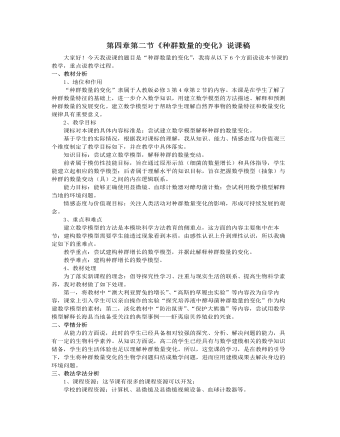
人教版高中生物必修3第四章第二节《种群数量的变化》说课稿
4、种群数量变化的其他类型我结合“种群数量下降”这个知识点对学生进行寓教。现今的自然界,许多野生生物种群的数量都在下降,为什么呢?我提供了世界人口近2000年的种群增长曲线,一切都在不言而喻中。现今社会的主题是呼吁建立和谐社会,作为生物老师,我想它不应该仅仅指人与人之间的和谐,也不应该仅仅指人与社会之间的和谐,它更应该昭示着人与自然之间的和谐,人类只有学会与自然和谐相处,才能在生物圈中享受最大的幸福。6、小结课程在实验的大背景下展开,也在实验的背景中结束,这里可以呈现出一个完整的探究思路。同时,学生思考如何实现多种预期过程,相当于对本课进行小结。五、效果预测课堂上选取的内容基于学生的生活体验,创设的情境能激发学生的兴趣,设置的问题符合学生的认知水平,有助于学生能力的提高,教学目标可以基本实现。
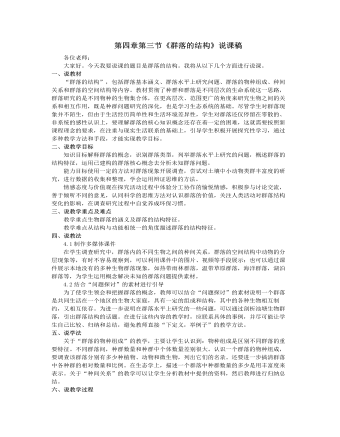
人教版高中生物必修3第四章第三节《群落的结构》说课稿
建构群落特征3群落有一定的空间结构,包括垂直结构和水平结构。思维拓展从结构与功能相统一的角度思考群落内的分层结构的意义。6.4运用群落核心知识概念解决未知群落问题学生已掌握了同一时间内聚集在一定区域中各种生物种群的集合是生物群落,所有群落都有一定的物种组成、种间关系、空间结构,不同群落主要表现在其具体特征上的差异。在此基础上,为学生提供新的问题情境,利用多媒体课件,展示不同生态环境下不同生物群落问题,让学生运用已建构的群落概念,通过分析、演绎和具体化等辩证思维的过程解决未知的群落问题,课件展示热带雨林、温带草原、海洋、湖泊等生物群落。学生运用概念说明不同的群落的物种丰富度差异,列举不同群落的种间关系,分析不同群落的垂直结构和水平结构,研究造成不同群落重要特征差异的原因。评价人类的活动对群落的结构的影响。
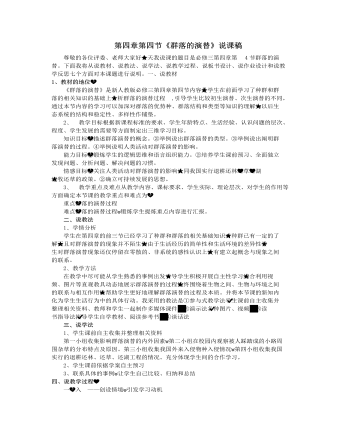
人教版高中生物必修3第四章第四节《群落的演替》说课稿
总结与大自然和谐相处走可持续发展道路。在我们的努力下地球一定能为我们人类提供更好的生存环境这部分的设计意图是培养学生综合实践能力把新知识内化为学生生活行为中的具体行动。五、说板书设计这样设计能直观形象地体现知识结构、突出重点难点、利于巩固新知识。六、说作业设计1、课本P80练习——常规作业主要为巩固和落实认知目标服务。2、活动与探究以“警惕外来物种入侵”为题写一篇科普文章。——开放性作业学生在自主完成任务的同时可以相互合作通过自主学习所获得的成果经共享共同整理、归纳、分类得到一种比较完整的答案。七、说教学反思1、本节教学过程主要重视运用“动态发展观”来组织实施教学用历史性的眼光从纵向进行寻踪综合利用视频、图片等直观教具动态地展示群落演替的过程帮助学生更好地理解群落演替的过程及本质。
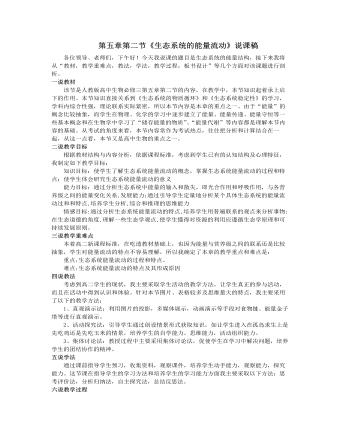
人教版高中生物必修3第五章第二节《生态系统的能量流动》说课稿
为使学生对知识达到深化理解、巩固提高的效果,我结合两个讨论题专门设计了一组即时训练题,做完后,屏幕展示汇总,以及时巩固新知。然后,进行当堂训练,这部分习题分AB两个层次,适合不同能力的学生做,做完后收上,课后批改后会了解学生掌握的情况,从而得到准确的学习信息。这部分用时约6分钟。三)结课组织学生总结本节课。引导学生可对照教学目标总结知识,从而尽快将知识形成能力;也可总结方法,从而理解生物学分析思路;还可以谈谈感想,从而理解人与自然的和谐相处的必要性。最后要求学生完成课后习题,课后时间允许的话还可组织有兴趣的同学进行对当地农田生态系统的能量流动情况得调查。这部分用时大约4分钟。七说板书设计生态系统的能量流动一概念:生态系统中能量的输入,传递和散失过程

人教版高中生物必修3第五章第四节《生态系统的信息传递》说课稿
教师通过引导学生看课本的“资料分析”,要求学生从中得出生态系统中的信息传递在生态系统中的作用。学生通过分析、讨论可以得出结论,这时教师要适时的点拨,给予小结,并引导学生站在整个生态系统的角度去分析信息传递,并和能量流动、物质循环联系在一起,说明它们都是生态系统各组分必不可少的一部分,同时指出信息传递是长期的生物进化的结果。学生了解了生态系统中信息传递的作用后,教师适时进行话题的转移,“我们学习信息传递,是为了更好的利用它,谁能说出信息传递在我们生产和生活中应用方面的例子”?学生们这时就开始讨论了,他们可能做不出正确的回答,但他们却能举出生活中有关信息传递的许多例子。讨论几分钟后,让看看信息传递在农业生产中有哪些应用吧?使教学回归课本,使知识得以沉淀,形成自己牢固的知识体系。(依时可以安排学生自学)
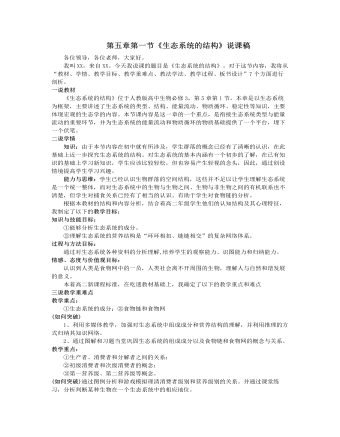
人教版高中生物必修3第五章第一节《生态系统的结构》说课稿
5、归纳小结,当堂演练(10分钟)1、肉食动物不可能是一条食物链中的第几营养级()A.第五B.第二C.第三D.第四2、对水稻→鼠→蛇→鹰这条食物链的错误描述是()A.水稻是生产者B.鼠是初级消费者C.蛇是次级消费者D.鹰属于第三营养级3、在下列生物中,属于分解的是()A.蓝藻B.草履虫C.蘑菇D.蝗虫4、从生态系统的组成成分看,硝化细菌和蚯蚓属于()A.生产者和分解者B.生产者和消费者C.消费者和分解者D.分解者和消费者5、下列哪组生物可和无机环境组成一个生态系统()A.水藻、鸟B.小鱼、大鱼C.小草、昆虫、细菌D.水藻、虾6、对草→昆虫→食虫鸟→鹰这条食物链的叙述,正确的是()A.有四个营养级,两个次级消费者B.有三个营养级,一个生产者C.食虫鸟是第三营养级、次级消费者D.有三个营养级,三个消费者(设计意图)进行简单扼要的课堂小结与练习,可以把课堂传授的知识尽快地转化为学生的素质;也可使学生更深刻地理解理论在实际生活中的应用。
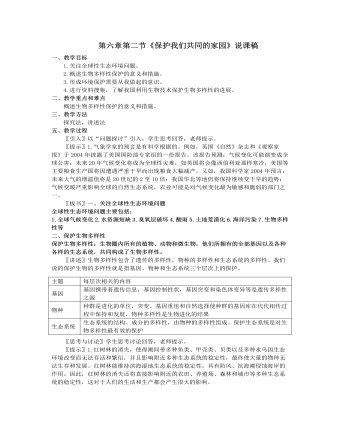
人教版高中生物必修3第六章第二节《保护我们共同的家园》说课稿
1.潜在价值──某种不知名的昆虫。间接价值──每个物种都维系着它们所在的生态系统的结构和功能。直接价值──芦苇是一种重要的造纸原料;蝉蜕是一种动物性药物;鲁班通过观察某种叶片的叶缘得到启示,研制出了木工用的锯;海洋和森林等生态系统能陶冶情操、激发创作的灵感。2.主要的困难是,一些发达国家(如美国、加拿大和欧盟国家等),拒绝核准或迟迟不予核准该议定书。主要争议的问题是,这些国家担心影响本国经济的发展和其他国家可能不承担相应的责任。例如,美国政府在2003年3月以“减少温室气体排放将会影响美国经济发展”和“发展中国家也应该承担减排和限排温室气体的义务”为由,宣布拒绝执行《京都议定书》。建议世界各国特别是发展中国家联合起来,通过联合国大会和各国的政府以及民间组织等多种途径,呼吁每年大量产生温室气体的发达国家率先核准《京都议定书》(我国政府早在2002年9月就核准了《京都议定书》)。
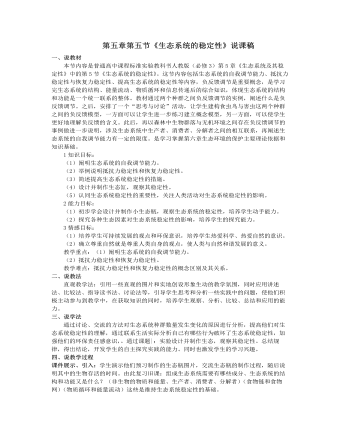
人教版高中生物必修3第五章第五节《生态系统的稳定性》说课稿
主要让学生明确以下观点:(1)自然生态系统是人类生存的基本环境;(2)人类活动的干扰正在全球范围内使生态系统偏离稳定状态;(3)人类生存与发展的命运就掌握在自己手中,但又受到自然规律的制约。反思总结,练习巩固:对本节知识点进行回顾,整理出简要的知识主线,为学生系统性复习巩固提供思路,课件展示老师课前收集准备的相关练习题,指导学生完成练习题,加学生深对本节知识的理解把握。结课布置作业:我们已经学习了生态系统的稳定性,那么,生态系统的各种功能之间的关系是怎样的呢?在下一节课我们一起来学习这一方面的内容。这节课后大家可以先预习这一部分,着重分析他们之间的关系。并完成本节的课后练习及课后延伸拓展作业。达到对本节内容知识的巩固提高和延展的目的。八、板书设计第五节生态系统的稳定性一、 生态系统的稳定性概念1.概念:生态系统所具有的保持或恢复自身结构和功能相对稳定的能力,
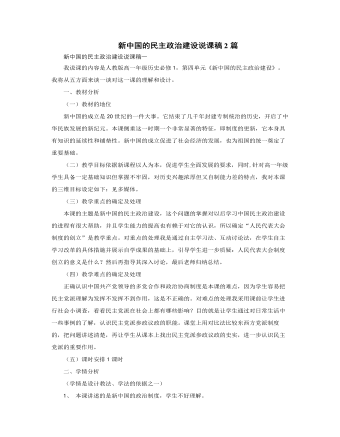
人教版高中历史必修1新中国的民主政治建设说课稿2篇
(一)教材的地位新中国的成立是20世纪的一件大事。它结束了几千年封建专制统治的历史,开启了中华民族发展的新纪元。本课侧重这一时期一个非常显著的特征,即制度的更新,它本身具有知识的延续性和铺垫性。新中国的成立促进了社会经济的发展,也为祖国的统一奠定了重要基础。(二)教学目标依据新课程以人为本,促进学生全面发展的要求,同时,针对高一年级学生具备一定基础知识但掌握不牢固,对历史兴趣浓厚但又自制能力差的特点,我对本课的三维目标设定如下:见多媒体。(三)教学重点的确定及处理本课的主题是新中国的民主政治建设,这个问题的掌握对以后学习中国民主政治建设的进程有很大帮助,并且学生能力的提高也有赖于对它的认识,所以确定“人民代表大会制度的创立”是教学重点。
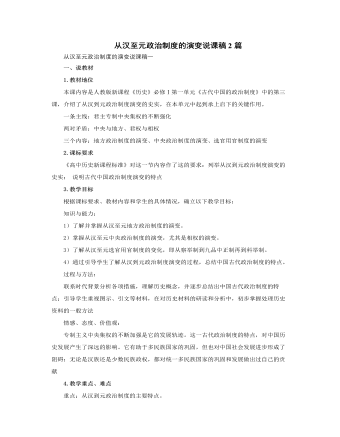
人教版高中历史必修1从汉至元政治制度的演变说课稿2篇
二、君主专制的演进(即中央政治制度的演变)通过地方政治制度演变的学习,掌握方法以后,以学生归纳整理基本线索为主,教师适当点拨,注意纠错。1. 汉承秦制,又有所变化。教师点拨强调继承与发展两个方面。创设情景:同学们看了电视连续剧《汉武大帝》后,知道汉武帝刘彻在继位之后,就急于对西汉王朝的政治制度进行改革。那么,西汉初期中央政治制度的基本框架是怎样的呢?汉武帝为什么要对它进行改革呢?改革后的西汉中央集权制度又是怎样的呢?请大家议一议,想一想。主干知识:西汉初期的中央政治制度的最大特点是“汉承秦制”。具体表现在两个方面:一是继续实行皇帝制度,维护皇权,这一做法也为后来各王朝所沿用;二是在中央设立三公,分别掌管行政、监察和军事。到汉武帝时,“中朝”成为西汉重要的中央决策机构,尚书令的权力日益重要,以丞相为首的三公九卿的权力被削弱,演化为执行机构。到了东汉光武帝时,进一步剥夺三公权限,扩大尚书的权力。
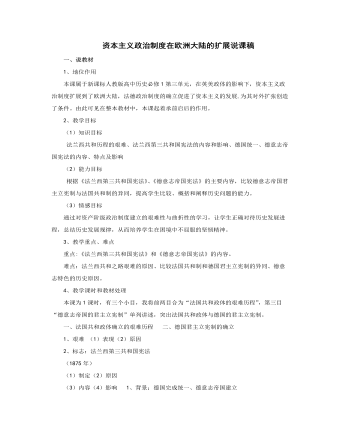
人教版高中历史必修1资本主义政治制度在欧洲大陆的扩展说课稿
1789年法国大革命后,共和派与君主派之间进行了长期反复的斗争,直到1875年法兰西第三共和国宪法通过才最终确立了共和政体,它为法国资本主义的进一步发展奠定了基础。专制色彩浓厚的普鲁士通过王朝战争这种自上而下的形式,完成了德国的统一。1871年德意志帝国宪法颁布,德国君主立宪政体确立,保留了浓厚的专制残余和军国主义传统。但资产阶级代议制的建立使德国的资本主义工业迅速发展起来,19世纪末跻身到世界强国行列。资本主义政治制度扩展到了欧洲大陆,随着这两个国家资本主义政治制度的确立,近代西方主要资本主义政治制度得以最终确立。四、板书一、法国共和政体确立的艰难历程1、艰难 (1)表现 (2)原因2、确立标志:法兰西第三共和国宪法
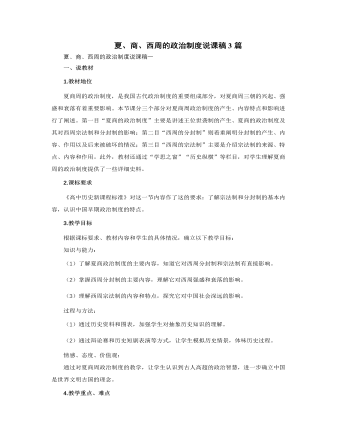
人教版高中历史必修1夏、商、西周的政治制度说课稿3篇
二、教学目标:(一)知识与能力:学生了解夏商周期的政治制度的内容和特点,对不同的政治制度有一个较为全面的认识。在此基础上,学生根据所学的知识,归纳和评价从夏到周政治发展的特点以及内在规律。(二)过程与方法:在学习的过程中,采用小组合作讨论的形式,让学生学会与他人合作与沟通,提高自主探究的技能。(三)情感态度与价值观:政治制度的不断更新是古人制度创新的结果,而这种制度的不断更新也推动文明的发展。这是古代先民的智慧结晶,学生要引以为豪。而通过本课的学习,可以增强学生们的民族自豪感。三、说教科书:本课作为高中历史教材的开篇,是认识整个古代政治文明史的起点,具有统领和示范作用。本课总共有三个子目,主要讲述了夏商周的政治制度。主要介绍了夏朝公共权力的出现,分封制的内容、分封的对象、 “以嫡长子继承制为核心的宗法制度”介绍了宗法制的来源、内容,以及礼乐制度的大致内容。
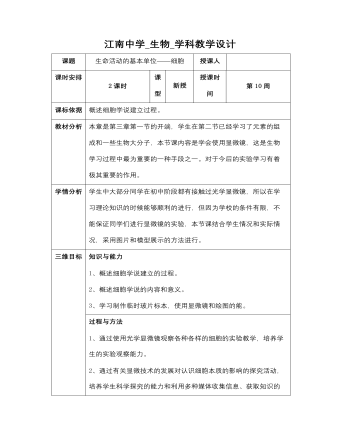
高中生物苏教版必修一《31生命活动及本单位-细胞》教案
本章是第三章第一节的开端,学生在第二节已经学习了元素的组成和一些生物大分子,本节课内容是学会使用显微镜,这是生物学习过程中最为重要的一种手段之一。对于今后的实验学习有着极其重要的作用。 学生中大部分同学在初中阶段都有接触过光学显微镜,所以在学习理论知识的时候能够顺利的进行,但因为学校的条件有限,不能保证同学们进行显微镜的实验,本节课结合学生情况和实际情况,采用图片和模型展示的方法进行。 知识与能力 1、概述细胞学说建立的过程。 2、概述细胞学说的内容和意义。 3、学习制作临时玻片标本,使用显微镜和绘图的能。
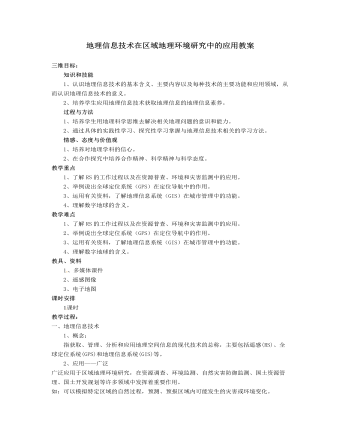
人教版高中地理必修3地理信息技术在区域地理环境研究中的应用教案
1.从监测的范围、速度,人力和财力的投入等方面看,遥感具有哪些特点?点拨:范围更广、速度更快、需要人力更少 、财力投入少。2.有人说:遥感是人的视力的延伸。你同意这种看法吗?点拨:同意。可以从遥感的定义分析。从某种意义上说,人们“看”的过程就是在遥感,眼睛相当于传感器。课堂小结:遥感技术是国土整治和区域发展研究中应用较广的技术 手段之一,我国在这个领域已经走在了世界的前列。我国的大部分土地已经获得了大比例尺的航空影像资料,成功发射了回收式国土资源卫星,自行研制发射了“风云”卫星。遥感技术为我国自然资源开发与利用提供 了大量的有用的资料,在我国农业估产、灾害监测 、矿产勘察、土地利用、环境管理与城乡规划中起到了非常重要的作用。板书设计§1.2地理信息技术在区域地理环境研究中的应用
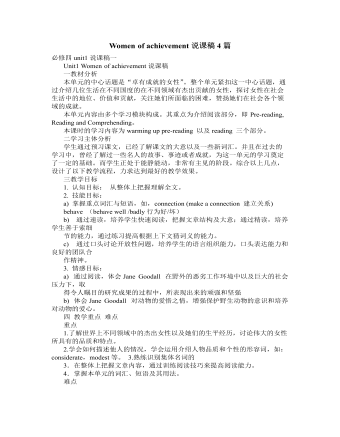
人教版高中英语必修4Women of achievement说课稿4篇
Good morning, distinguished judges:It’s my honor to talk about my teaching ideas with you. Today my topic is Women of Achievement. My presentation consists of six parts: the analysis of teaching material and student, teaching aims, key and difficult points, teaching and studying method, teaching procedures and blackboard design.First, let’s focus on the analysis of teaching material. This lesson is from New Senior English for China Student’s Book 4 Unit 1, the reading part. The main topic of the passage is the introduction of a student of Africanwildlife. After this lesson, the students will learn more information about her studying chimps in Africa, and their reading and speaking abilities can be developed as well.The next part is the analysis of students. My students are in senior high students. They have learnt English for many years, they’ve known many words and sentences, but their speaking and reading abilities are still not very good. So I will practice their speaking and reading abilities through different exercises.According to the New Standard Curriculum and the present situation, I set the teaching aims as follows: firstly, knowledge aims. Students can grasp some new words, such as worthwhile, move off. Moreover, students can understand the content of the passage and get familiar with the topic of studying chimps in wildlife. Secondly, ability aims. Students can use reading strategies such as skimming and scanning in reading process. Thirdly, emotional aims. Students can have the awareness of protecting animals and care about animals.Based on the above analysis, the key point of this lesson is to get the main idea and the detailed information from the passage; the difficult point is to talk about the wildlife protection and use reading strategies.
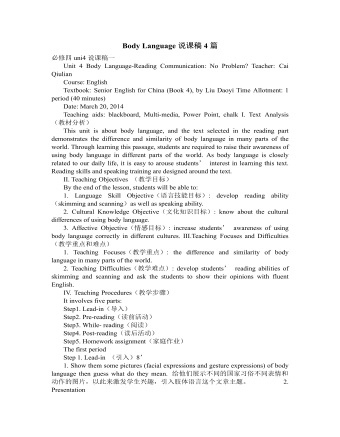
人教版高中英语必修4Body Language说课稿4篇
Textbook: Senior English for China (Book 4), by Liu Daoyi Time Allotment: 1 period (40 minutes)Date: March 20, 2014Teaching aids: blackboard, Multi-media, Power Point, chalk I. Text Analysis (教材分析)This unit is about body language, and the text selected in the reading part demonstrates the difference and similarity of body language in many parts of the world. Through learning this passage, students are required to raise their awareness of using body language in different parts of the world. As body language is closely related to our daily life, it is easy to arouse students’ interest in learning this text. Reading skills and speaking training are designed around the text.II. Teaching Objectives (教学目标)By the end of the lesson, students will be able to:1. Language Skill Objective(语言技能目标): develop reading ability (skimming and scanning)as well as speaking ability.2. Cultural Knowledge Objective(文化知识目标): know about the cultural differences of using body language.3. Affective Objective(情感目标): increase students’ awareness of using body language correctly in different cultures. III.Teaching Focuses and Difficulties(教学重点和难点)1. Teaching Focuses(教学重点): the difference and similarity of body language in many parts of the world.2. Teaching Difficulties(教学难点): develop students’ reading abilities of skimming and scanning and ask the students to show their opinions with fluent English.
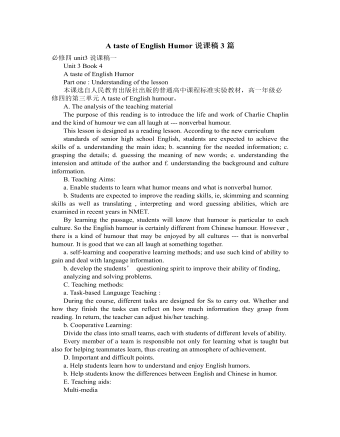
人教版高中英语必修4A taste of English Humor说课稿3篇
Then I would ask them to think of a funny English or Chinese and tell it to partners. While telling stories, they can use expressions and some acting to help make the story funny. 5 minutes would be given to do this.Those stories they told there will be the material for their writing. Soletting them tell it at first is helpful. And they can make a difference between telling a funny story and writing it down. Generally speaking, it is difficult forstudents to write well because they don’t know what to write and how to write. Asking them to tell their own stories at first can help them come up with what to write.After their telling, I would invite someone to share his/her story with all of us and I would write it down on the blackboard.This example story would be used as a sample to illustrate the format of funny story. Different from a story from teacher or textbook, a story from students can obviously become a interesting material to draw students’ attention.Then I would ask the whole class to put this story into several parts. It might be a little bit difficult for them. So I would ask them to find out whether all the sentences are necessary. After delete some sentences, there are 6 sentences left behind. Then they can easily put them into three parts. After interaction with students, I would teach them the right terms for each part and conclude the format of funny story.This step is the key and difficult point in my lesson. So I mainly usetask-based teaching method in this part and the task for students was divided into several stages. With the separated difficult level, students can find there are usually three parts in writing. They can also learn to write without the unnecessary parts in the process of analyzing. And then I wouldn’t rush to tell them the right terms to them directly. Instead, I would ask them to name them by their own. A confused mind is better for acquiring knowledge.While-writing:Then I would give students 7 minutes to write down this story, without other requirements.With all the preparations in pre-writing, students’ difficulties were cleared. So it would be much easier for them to write down the story within 7 minutes. There are no other requirements because students’ first writing is actually a drafting. It would be revise and edit several times later. Writing, as a skill
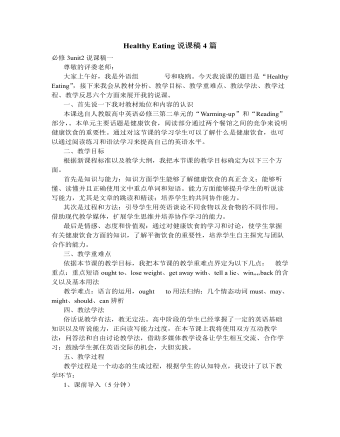
人教版高中英语必修3Healthy Eating说课稿4篇
Language learning needs a context, which can help the learners to understand the language and then can product comprehensible output, so computer has the advantages to make the materials attractive.Part 3 Learning MethodsTask-based, self-dependent and cooperative learningPart 4 Teaching ProcedureStep One Lead-in“Interest is the best teacher.” Therefore, at the very beginning of the class, I should spark the students’ mind to focus on the centre topic “the band”. I’ll show some pictures of food to attract their attention and then bring some questions.Question:What kind of food they like?What should go into a good meal?The answers must relate to the diet. After this, the students will be eager to know something about a balance diet and this is the very time to naturally lead the class into Step 2Step 2 Reading for information: skimming and scanning In this step, I use Task-based Language Teaching method, which can give students a clear and specific purpose while skimming and scanning the context.Task 1 General ideaThe students will be asked to just glance at the title and the pictures of the passage, and then guess what they will read in the text. And they’ll be divided into groups of four to have a discussion.The purpose is to inspire the students to read actively, not passively. In addition, the task is to develop the students’ reading skill by making prediction and to encourage the students to express their thoughts in English and cooperate with each other.Task 2 Main idea of each paragraphCooperative learning can raise the students’ interest and create an atmosphere of achievement. Based on this theory, I divide the whole class into 4 groups to skim the whole text and get the main idea of each paragraph.
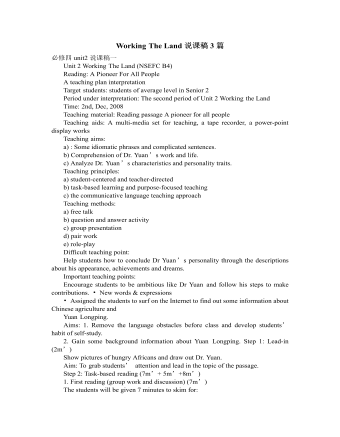
人教版高中英语必修4Working The Land说课稿3篇
Knowledge objectives:(1) to make Ss grasp the usage of words, expressions and sentence structures: statistics, struggle, thanks to, rid of, some patterns for persuasion, the “ing” form as subject and object;(2)to use learnt knowledge to persuade sb.Ability objectives:(1) to develop Ss’ reading skills(skimming, scanning, word guessing);(2) to improve Ss’ speaking, communicating and cooperating skills.Emotional objectives:to make Ss know the contribution of Yuan,and learn his spirit and his simple life time.Teaching important and difficult points:(1) some words, expressions and sentence structures mentioned above;(2)the content of the text;(3)training their reading and speaking skills.Teaching methods: CLT, TBLT,QT.Learning strategies: CLS, QLS, TBLS.Teaching procedures:Step 1 lead-in: (1) teacher plays a piece of recent news from CCTV about the harvest of the super hybrid rice, and ask students whether they know Yuan or not, and talk about him and his contribution.(2)Brain storm: let Ss describe Yuan in their minds including his appearance, his living condition and so on.Step 2 fast reading tasks:(1)teacher introduces Yuan and super hybrid rice(2)make Ss read the text as fast as possible with questions. Such as: what’s the general ideaof this passage? What’s Yuan’ dream? (skimming and scanning skill)Step 3 intensive reading tasks(1)let Ss read the text silently, find topic sentence of each paragraph and draw the difficult sentences and the knowledge what they don’t understand.(words guessing)(2)teacher and Ss talk about the important words, expressions and sentences together, and ask Ss to retell the content of the text.(summarizing and paraphrasing)(3)teacher summarize this part.(4) read again following the courseware.
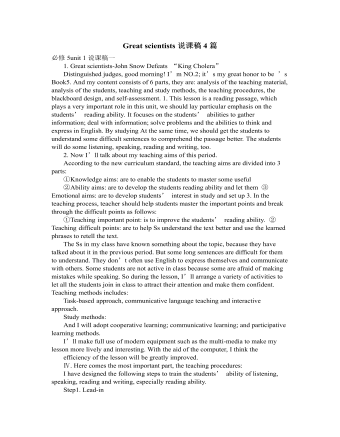
人教版高中英语必修5Great scientists说课稿4篇
通过写文章梗概,培养学生综合运用语言的能力,学习用恰当的英语描述科学家的故事。这是本课的教学难点。教师可以使用完形填空的方式来帮助学生整理语篇,从而来降低难度。本课的教学重点的突破方法是:在阅读前,让学生初步了解得出科学观点所需要的基本程序,从而轻松而自然地导入文章的阅读;在阅读过程中,由易到难设计快速阅读和精读的问题,层层推进各种阅读活动,让学生对阅读内容从整体感知到细节理解,最后深层读懂整篇文章,同时加强阅读策略的指导,让每个学生都主动参与课堂教学活动,最终达到提高阅读能力的目的。Step 4 Post-readingGroup Activities四人小组共同合作,在老师的适当指导下,就以下2个问题展开讨论,让学生就所知、所学、所感和所想融入话题,然后抽若干同学代表作小组发言。1. What do you think about John Snow, and what should we learn from him?2. Cholera was 19th century disease, which two diseases are similar to cholera today? Why?





















